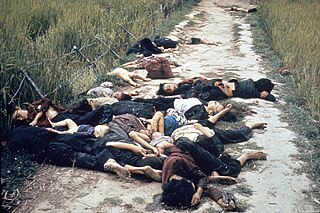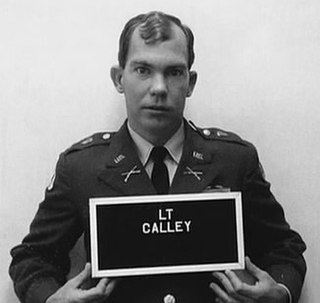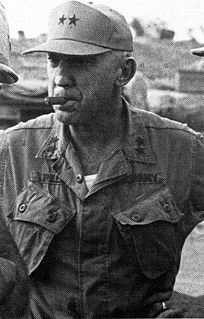 W
WThe Mỹ Lai massacre was the mass murder of unarmed South Vietnamese civilians by U.S. troops in Sơn Tịnh District, South Vietnam, on 16 March 1968 during the Vietnam War. Between 347 and 504 unarmed people were killed by U.S. Army soldiers from Company C, 1st Battalion, 20th Infantry Regiment and Company B, 4th Battalion, 3rd Infantry Regiment, 11th Brigade, 23rd (Americal) Infantry Division. Victims included men, women, children, and infants. Some of the women were gang-raped and their bodies mutilated, as were children as young as 12. Twenty-six soldiers were charged with criminal offenses, but only Lieutenant William Calley Jr., a platoon leader in C Company, was convicted. Found guilty of killing 22 villagers, he was originally given a life sentence, but served only three-and-a-half years under house arrest.
 W
WAnd babies is an iconic anti-Vietnam War poster. It is a famous example of "propaganda art" from the Vietnam War, that uses a color photograph of the My Lai Massacre taken by U.S. combat photographer Ronald L. Haeberle on March 16, 1968. It shows about a dozen dead and partly naked South Vietnamese women and babies in contorted positions stacked together on a dirt road, killed by U.S. forces. The picture is overlaid in semi-transparent blood-red lettering that asks along the top "Q. And babies?", and at the bottom answers "A. And babies." The quote is from a Mike Wallace CBS News television interview with U.S. soldier Paul Meadlo, who participated in the massacre. The lettering was sourced from The New York Times, which printed a transcript of the Meadlo interview the day after.
 W
WWilliam Laws Calley Jr. is a former United States Army officer and war criminal convicted by court-martial for the premeditated killings of 22 unarmed South Vietnamese civilians in the Mỹ Lai massacre on March 16, 1968, during the Vietnam War. Calley was released to house arrest under orders by President Richard Nixon three days after his conviction. A new trial was ordered by the United States Court of Appeals for the Fifth Circuit but that ruling was overturned by the United States Supreme Court. Calley served three years of house arrest for the murders. Public opinion about Calley was divided.
 W
WFour Hours in My Lai is a 1989 television documentary made by Yorkshire Television concerning the 1968 My Lai Massacre by the U.S. Army during the Vietnam War. The film includes interviews with soldiers at the massacre, and the later trials of those involved. The programme first broadcast on ITV as part of Yorkshire Television's First Tuesday documentaries. Michael Bilton and Kevin Sim, who created the film, based a book of the same name off the documentary. The book, which is still in print in the United States and the UK, has also been translated and published in Japan. It remains on the reading list around the world of many college and university courses on the Vietnam War.
 W
WRonald L. Haeberle is a former United States Army photographer best known for the photographs he took of the My Lai Massacre on March 16, 1968.
 W
WSeymour Myron "Sy" Hersh is an American investigative journalist and political writer. He was a longtime contributor to The New Yorker magazine on national security matters and has also written for the London Review of Books since 2013.
 W
WOran K. Henderson was a United States Army colonel who commanded the 11th Infantry Brigade, 23rd Infantry Division during the Vietnam War and later served as head of the Pennsylvania Emergency Management Agency in the late 1970s. He is most famous for his role in the My Lai massacre where he served as brigade commander for the units involved in the killings, ultimately being charged and acquitted of dereliction of duty for failing to carry out an adequate investigation and lying to Army investigators. He was the highest-ranking Army officer to be tried in connection with the killings. Prior to the Vietnam War, Henderson had served as an infantry officer in World War II and the Korean War.
 W
WSamuel William Koster was the highest-ranking United States Army officer punished in connection with the My Lai Massacre. Koster was slated for promotion to the rank of lieutenant general at the time he was charged, but was demoted and ended his military career in mild disgrace.
 W
WWilliam Ray Peers was a United States Army general, who is most notable for presiding over the Peers Commission investigation into the My Lai massacre and other similar war crimes during the Vietnam War.
 W
WColin Luther Powell is an American politician, diplomat and retired four-star general who served as the 65th United States Secretary of State from 2001 to 2005. Powell was the first African-American Secretary of State. Prior to the election of Barack Obama as president in 2008, Powell and his successor, Condoleezza Rice, were the highest-ranking African Americans in the history of the federal executive branch. Powell served as the 16th United States National Security Advisor from 1987 to 1989 and as the 12th Chairman of the Joint Chiefs of Staff from 1989 to 1993.
 W
WRonald Lee Ridenhour was a young GI who served in the 11th Infantry Brigade during the Vietnam War, and played a central role in spurring the investigation of the Mỹ Lai massacre.
 W
WHugh Clowers Thompson Jr. was a United States Army Major, and a former warrant officer in the 123rd Aviation Battalion of the 23rd Infantry Division. He is credited with ending the Mỹ Lai Massacre of the South Vietnamese village known as Sơn Mỹ on March 16, 1968, alongside and above-hierarchically Glenn Andreotta and Lawrence Colburn.